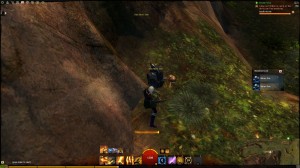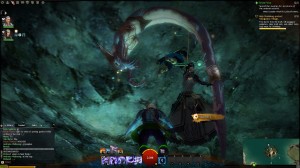One of the defining characteristics of the Guild Wars series has been its use of instances; unique events in MMO worlds that are separated from the bulk of the normal world. In many games, such events are used for unique mob spawns, such as boss battles, or special events that for whatever reason are an on-demand event.
In the original Guild Wars, the entire field was instanced per-party. While in town, everyone would be able to interact with everyone else, once you went out into combat areas, you had your own, unique instance generated for your party. This, of course, gave the world a very empty feel, but at the same time, ensured that there was virtually no such thing is kill stealing or item looting from enemy drops; it was just your party, and no one else to bother you.
What this also meant was that, in conjunction with the game giving you an assortment of NPC’s to party with, you could effectively play the game solo, without ever actually having another human player involved! For a gamer like me, who actually generally doesn’t like to play games with others, it was nice to not feel forced to party every time I wanted to get anything done in game. Such was always a deterrent to my willingness to play such games. With Guild Wars, this was not an issue.
Guild Wars 2, however, does things a little differently. Towns are no longer separated from the field area, which means that the idea of instances for combat zones is, with the exclusion of story based events, a thing of the past. In any other games, this would be a major issue, but in Guild Wars 2, a few changes to the way the game functions, in comparison to other MMO’s, give it a unique position in the online gaming universe.
Under normal circumstances, jumping in and damaging / killing a mob someone else has engaged in combat with would be frowned upon as an attempt at kill stealing. Arena Net, the creators of the Guild Wars series, have countered this issue by benefiting ALL players with proper experience, upon an enemy being defeated, rather than splitting it up, or offering it only to the player / party that defeated the mob. Everyone wins when you join in for a kill.
Of course, the next thought on any gamers mind would be, what happens to the drops from these defeated enemies? This is where the game goes from being good to amazing. Drops are instanced for each player specifically. If a mob is defeated, you may see a sparkling glow around its body, indicating it has items for you to recover. These are specific to you, and cannot be seen, or ever taken, by another player. If you see a drop, then you don’t have to think about it or ask who wants it: you just take it!
This methodology extends out in the game to resource gathering as well: mining, harvesting, and wood gathering points are all instanced for each player. While the locations are the same for each player, when you gather a resource, you do just for your own character. Indeed, it is common to see parties in World vs World moving from battle to battle, stopping in a group to gather resources when an opportunity presents itself, everyone collecting items unique to them.

Resource nodes are also instanced: a dozen others could come up, and mine, and we would all get items regardless of what the other players get or do.
In a reversal, some events in game, instead of being instanced, are set up for anyone in the area to join in on. Killing X enemies or gathering Y amount of items becomes a group event, and even adding one kill or one item to the total will, upon completion, get you a reward and completion of that event. Of course, the more you participate in the event, the better rewards you get, so it is in your best interest to do everything you can to help out, but if you arrive late to the event, this system ensures you still get to just jump in and complete it.

